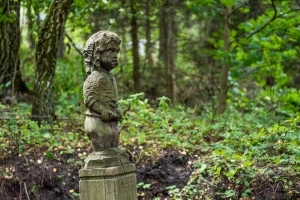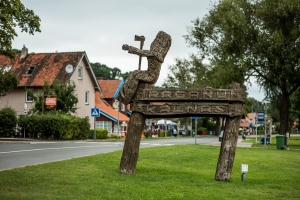Sightseers in Neringa have been fascinated and intrigued by the Hill of Witches wooden sculpture park for forty years now since its creation in 1979, when wood carving artists and blacksmiths from all over Lithuania were invited to Juodkrantė. The Hill of Witches exposition of wooden sculptures starts on the stone stairs which lead through two historic landscape artefacts – the Hill of Eve (Ger. Evaberg) and the Wilhelm heights (Ger. Wilhelmshöhe). The two names remind us about the glorious past of the resort. Indeed, the 19th century was a time for momentous changes for a small fishing village of Juodkrantė (Ger. Schwarzort).
In 1833 the entire Curonian Spit, including Juodkrantė lost its role as a postal station on the Paris-Berlin-St. Petersburg postal route of the European significance which used to lead through the Curonian Spit. Moving sand dunes threatened to bury a small fishing village adjoining the lagoon. However, the village managed to survive. Firstly, because of the Curonian Spit plantation works which were very intensive during second half of the 19th century. There were several other circumstances which were important for Juodkrantė’s survival, too. Namely, the lagoon waterway was deepened in the 19th century, due to which steamboats started to sail to Juodkrantė regularly. The fishing village which was separated from the outside World for centuries began attracting people for Memel, Tilsit and Königsberg who were looking for beautiful recreational nature spots. Besides, in 1861, when the Stantien & Becker company launched amber extraction from the lagoon just next to Juodkrantė, the former fishing village soon transformed into a resort. Already in 1865, an old village tavern was turned into a guest house and later into a large hotel which was named the Curonian Court (Ger. Kurischer Hof). The whole infrastructure of the resort was built during several decades, including hotels, villas, the pier, etc. Juodkrantė’s forest with old pines and spruce trees growing on high parabolic dunes was an important part of image making for the resort. In order to use its distinctive landscape turning it into attraction for holiday makers, there were walking paths - promenades set up in the forest. Today, an exposition of wooden sculptures carved after characters of Lithuanian folktales is arranged in of these old promenades, which you are welcome to visit now.
At the end of the 20th century, the remaining forest park promenades triggered the idea to create a recreational walking path decorated by wooden sculptures. The popular folktale characters – mostly witches and devils – were chosen to be the main theme for this new walking path sculpture exposition. Wood carving artists drew their inspiration from the surrounding landscape – steep sloped parabolic dunes, ancient pines and spruce trees created a truly mystic atmosphere. It is a special spot in the Curonian spit, not be found anywhere else on the whole peninsula.
How did the exposition of wooden sculptures come into being? During the 1970s, camps for folk artists - wood carvers became popular in Lithuania. During such camps entire sculpture parks were created, for instance, the Čiurlionis Road (in Druskininkai and Varėna municipalities), Ablinga Memorial Sculpture Park, etc. In 1979, Neringa municipality, inspired by the success of similar sculpture camps, set up a wood-carver camp in Juodkrantė, dedicating their works for the International Year of the Child. The creative camp, which was attended not only by wood carvers and also by blacksmiths, was organised by sculptor Steponas Šarapovas and architect Algimantas Nasvytis. The camp was managed by art critic of the Lithuanian Chamber of Folk Art Aldona Ulevičienė, and artist from the Folk Art Society Romualdas Navickas. The Juodkrantė creative camp was organised differently from other similar camps in Lithuania: in order to avoid unwanted pieces, artists had to select a theme for their work and prepare its model in advance, which then was evaluated by a panel of respected judges. This preparatory stage allowed to sift out inferior, unmatching artwork. During three folk-artists’ camps from 1979 through 1981, fifty wood carvers and blacksmiths created 71 sculpture for the Juodkrantė Hill of Witches walking path exposition.
Later on, the exposition was renewed and supplemented by new works. In 1988, there were 12 new play sculptures added. In 1999, renovation started as the old sculptures stood untouched and decayed during the several decades. In 2002, some of the sculptures which did not withstand the humid seaside climate, were replaced with new ones.
The oak trees, turned into artwork, stand on the Hill of Witches letting us to admire keen wits of folk artists; they invite us to play, to inhabit the world of Neringa’s legends and tales, to reflect on persistence and determination of human nature due to which it became possible to reclaim this land from the sand and wind.
You can find a map and a virtual exhibition of the Hill of Witches here.


